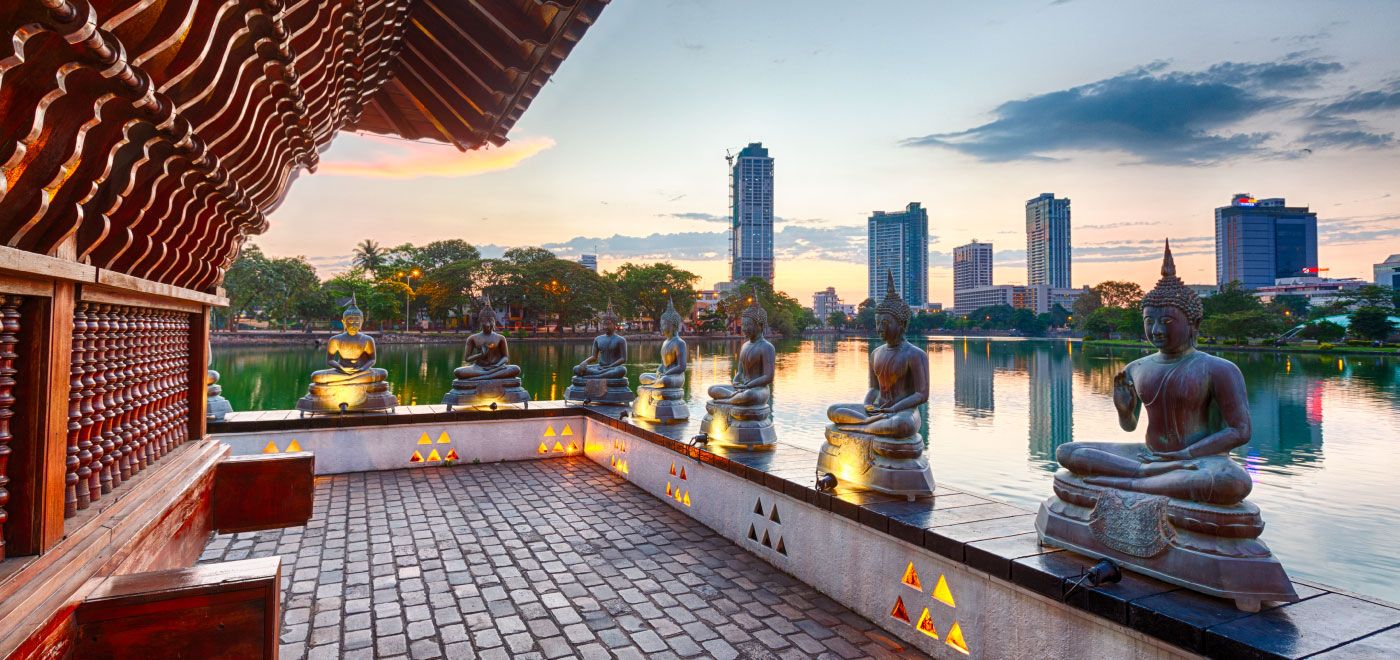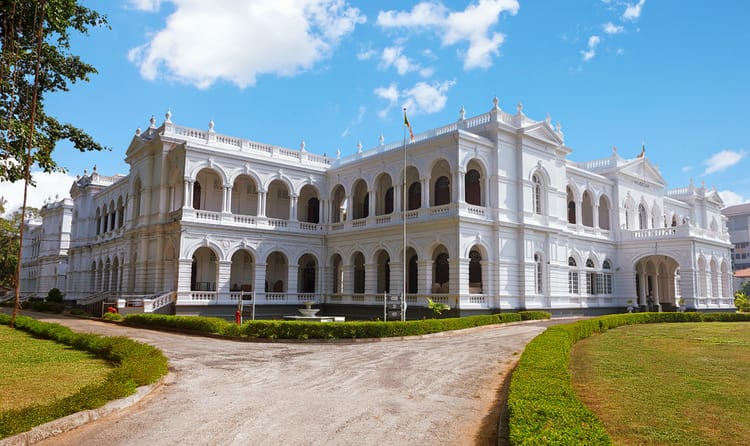COLOMBO
Colombo is a colorful multi-ethnic contrast town that is quickly becoming a must-see destination for globe-wide tourists. According to US broadcaster CNN, the cultural and commercial capital of Sri Lanka is the fastest growing tourist town in the world, with an increase of 21 percent in 2015, while six of the top ten are also in Asia. A wealthy combination of land and water, Colombo city boasts a network of canals linked to the surrounding river Kelani, which joins the ocean just south of the town and for centuries has been a crucial business and defensive waterway.
From here, the historic Hamilton Canal which recently benefited from a multi-million dollar facelift, runs north 35 km to Negombo, a famous beach resort through a wetland nature reserve. And head south to Pettah, a vibrant and colourful district of tiny stores and roadside stalls selling everything from food to clothing to the recent advanced electronic equipment, for an authentic Colombo shopping experience. This could not be a higher contrast to the gentrification of the historic Fort region and adjacent Galle Face Green, a lovely open space ribbon next to the Indian Ocean shore, and an increasingly famous resident and tourist destination.
Other famous Colombo tour packages highlights include the Gangaramaya Buddhist Temple, an eclectic mix of Sri Lankan, Thai, Indian, and Chinese architecture, Viharamahadevi Park, next to the Colombo National Museum, and the 65-hectare Beira Lake, a landmark in Colombo that frequently hosts regattas, cultural activities, and theatrical entertainment. Colombo natural harbor has been making it a magnet for Indian, Greek, Persian, Roman, Arab and Chinese spice traders for over 2,000 years, who later made their homes on our island of paradise and added so much to our wealthy cultural endowment.
ATTRACTIONS IN COLOMBO

GANGARAMAYA BUDDHIST TEMPLE
Built on land reclaimed from Colombo city’s landmark Beira Lake, the Gangaramaya Temple complex includes the Simamalaka Shrine, designed by renowned Sri Lankan architect Geoffrey Bawa. It was originally intended to be, and still is, a place where people of all religious persuasions can find peace and solace, which is reflected in its somewhat eclectic mix of Sri Lankan, Thai, Indian, and Chinese architecture.
Thus Gangaramaya is not only as a place of Buddhist worship, but also an internationally recognized center of learning that has helped establish Buddhist temple throughout the world. The complex includes a museum, library, residential hall, three storeyed Pirivena, educational halls and an alms hall, and is closely involved in Buddhist welfare work including old peoples' homes, a vocational school and an orphanage.

KELANIYA RAJAMAHA VIHARA
Just outside Colombo is one of the most sacred and historic Buddhist sites in the country, the Kelaniya Raja Maha Vihara or Kelaniya Temple. It is here that Lord Buddha made his third and last visit to Sri Lanka, and the Mahawansa records that the original stupa included a gem-studded throne on which the Buddha sat and preached.
The temple is the focus of the traditional Duruthu Maha Perehera procession each January, and is renowned for its reclining Buddha and paintings by artist Solias Mendis depicting important events in the history of Buddhism in Sri Lanka. It has a chequered past. The original temple was destroyed by Indian invaders, restored and later destroyed again by the Portuguese, and finally restored to its present condition by the Dutch.

OLD PARLIAMENT BUILDING
Sri Lankan architectural historian Ismeth Raheem described the Old Parliament Building in Colombo city, an imposing monument to Sri Lanka’s imperial past, as a “masterpiece in stone”. Built by the British to house Ceylon’s Legislative Council, this striking neo-classical edifice is now occupied by the Presidential Secretariat and Executive President.
With it colonnades and pediments, today the building is the venue for state functions and the presentation of credentials by incoming ambassadors and high commissioners. One of its most striking features is the use of rare brown granite from a quarry near Ruwanwella, 65km east of Colombo, which was transported in barges down the Kelani Ganga river and into the nearby Beira Lake via a specially built canal.

ALL SAINTS CHURCH
Colombo city is redolent with examples of its British, Portuguese and Dutch colonial past, a prime example of the latter being All Saints Church, perched atop what remains of the city’s old defensive wall. Featuring outstanding European-style Gothic architecture, it was built and consecrated in 1865, and retains nearly all of its original, richly carved furniture and wood-carving.
A link with Colombo’s increasing modernity is one of the leading colonial families, the Bandaranaikes, who not only provided trustees for the church but also gave their name to Sri Lanka’s international airport. Though it is hidden among legal offices and the other ancient buildings, this church, with its 145-year history, is well worth seeking out.

JAMI UL-ALFAR MOSQUE
One of the oldest mosques in Colombo city, the striking-looking Jami-Ul-Alfar was reputedly built at the request of Muslim shopkeepers in the bustling Pettah Bazaar to make it easier to attend Friday prayers. A landmark building, with its red and white horizontal stripes, minarets and cupolas, it dominates one of the main streets of this north Colombo district, itself a major tourist attraction. Jami-Ul-Alfar Mosque was completed in 1909, and in those days, before other taller and more notable landmarks were built, it was used as a navigational reference point by sailors approaching the nearby port.

OLD TOWN HALL
This charming and idiosyncratic building, tucked away in the heart of north Colombo’s bustling Pettah market, is regarded as something of a minor architectural masterpiece. Now a museum containing many equally charming and idiosyncratic not to say bizarre and extraordinary relics of Colombo’s colonial past, it fell into neglected disuse after the Colombo Municipal Council moved to the present Town Hall fronting Viharamahadevi Park in 1928.
For 50 year, the old building unceremoniously discarded like an old dowager in her dotage served as a public market until it was reclaimed by the authorities in 1979. Among the museum’s electic exhibits are a steam roller and a steam lorry, Colombo’s first printing press, the first mobile library vehicle and one of the city’s first garbage trucks. Not to be missed.

SAMBODHI CHAITHYA
One of the most amazing sights in Colombo is the gleaming white Buddhist stupa built atop an arch just beside the Sri Lankan Navy base in the Fort area. Adjacent to the harbor, this bell-shaped landmark was created so that it would be visible to all ocean going ships, whether docking at the port or in transit to far-flung destinations around the world.
Access to the arch is via a gantry at the top of a tower to the north, itself accessed by an open staircase, the ascent of which is not for the weak-limbed or faint-hearted! Next to the temple grounds, known as the Sambodhi Chaitya, is the Colombo Maritime Museum, housed in what used to be the old Dutch Prison, which is also well worth a visit.

COLOMBO LIGHTHOUSE
Sri Lanka’s seafaring tradition is a cornerstone of its history and culture, one that fostered its centuries-old trade in gems and spices throughout Asia, Arabia and the Far East. Today, the thousands of cargo ships that call at Colombo port every year from around the world rely on GPS and satellite navigation to tell them exactly where they are as they approach their destination.
But back then, ships captains depended on rather less sophisticated navigational aids, including one that is now an iconic Colombo landmark—The Lighthouse. Built in 1952 after the Old Colombo Lighthouse was decommissioned, it was opened by D.S. Senanayake, the first prime minister of newly independent Sri Lanka. At its base is a battery of naval guns that are used to salute National Day, including two that were installed in 1952 to mark the visit of then Princess Elizabeth of Great Britain.

COLOMBO FORT RAILWAY STATION
Fort Railway Station, in the heart of Sri Lanka’s commercial capital of Colombo, was built by the British in 1917, and is strongly reminiscent of the celebrated Manchester Victoria station in the UK. The rapid development of pre-independence Ceylon’s rail infrastructure mirrors the export value of coffee, tea, coconut and rubber to our economic development.
Built on land reclaimed from Beira Lake, the station is now the Colombo city terminus and connection point for all the main lines leading north, south and east, including the express link to the international airport. It is also a start point for visits to our many upcountry tourist destinations, providing train journeys that have been lauded as being among the most beautiful and scenic in the world.

VIHARAMAHADEVI PARK
This beautiful and historic green oasis—it was originally named Victoria Park by the British—is the oldest and biggest public open space in Colombo city. Apart from being a welcome refuge from the hustle and bustle, it also hosts the Cenotaph War Memorial, the public library, and the Vihara Maha Devi Park Open Air Stadium, a popular venue for concerts and public events.
In the past, entrance to the park was restricted to three locations, but since nearly all of the fencing around the area has now been taken down, there is walk-in access from just about everywhere. Features include the long square pools in the center, an aquarium, and a host of ancient trees towering over the meticulously maintained grassy areas and paved pathways. As might be expected, during the evening and at night this most romantic of settings is a favorite for young courting couples.

NATIONAL ZOOLOGICAL GARDENS OF SRI LANKA
The breeding and conservation programs at the National Zoological Gardens, better known as Colombo Zoo, are key parts of Sri Lanka’s commitment to developing and expanding eco-tourism on the island. The zoo exists ‘to create one of the world’s outstanding zoological institutions, that is a centre of the excellence for conservation, research and education’, with the ‘resourceful conservation of animals’.
Its beautiful animal parks provide some of the few places where nature and a huge variety of animal life are able to co-exist with a busy and rapidly expanding urban landscape. Natural habitat are provided by dense tree coverage and small forest patches that are rich in rare plants, including valuable herbal species that contribute to Sri Lanka’s renowned tradition of natural medicine.

COLOMBO NATIONAL MUSEUM
A national museum can be more than just the memory of a nation, a collection of artifacts of historic and cultural significance. It can also hold the legacy of a nation’s journey to statehood. Colombo National Museum is no exception. It not only safeguards the ancient royal regalia, including the throne and crown of the Kandyan kings, it is also the national library.
As such, by law, it holds a copy of every document printed in the country: over 12 million to date covering, amongst other subjects, the arts and humanities; natural sciences; and palm leaves inscribed in Sinhala, Pali, Sanskrit, Burmese, Telugu and Tamil characters. The museum was constructed in Colombo city in 1877 by Wapchie Marikar, of the Sheiq Fareed family, which arrived in Ceylon in 1060 AD. Wapchi Marikar also built Colombo’s General Post Office, Old Town Hall in Pettah, Galle Face Hotel, Victoria Arcade, the Clock Tower, and many notable local landmarks still standing today.
